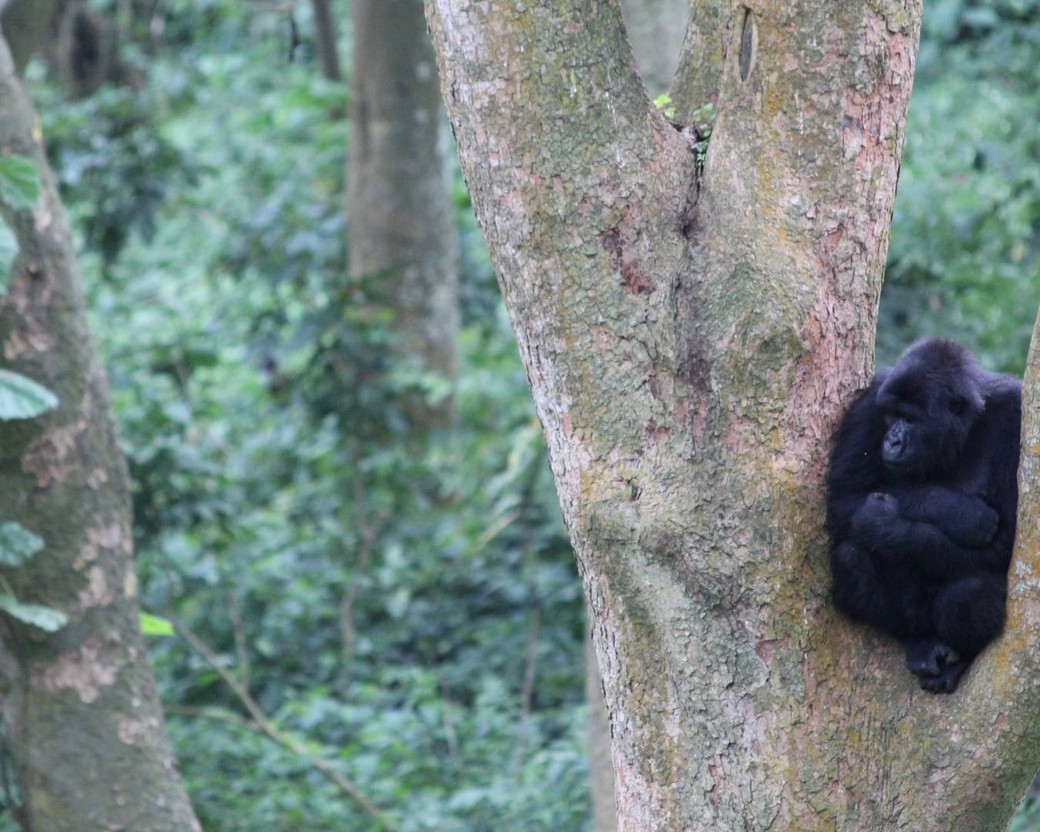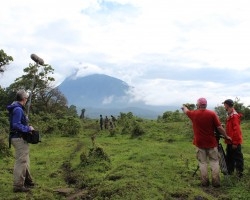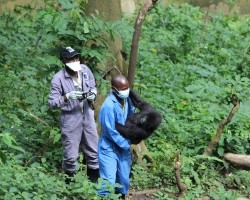
Gorilla Doctors: Problems and Solutions
In conjunction with the Canadian Museum of Nature’s screening of Gorilla Doctors, OLM will be publishing a three-part series written by the documentary cinematographer Michael Boland. The screening takes place Thursday, October 9.
Part Three: Problems & Solutions
Gorilla Health Care
Approximately 70 per cent of the habituated mountain gorilla population are used for ecotourism, specifically in Rwanda, which brings in $270 million of foreign income. But, “because gorillas share 98.5 per cent of their DNA with humans, they are susceptible to most human diseases,” said Dr. Cranfield. “They can become exposed to human diseases with potential transmission from the local communities, ecotourism and the trackers and guides—in all, thousands of people a year. In a suspected outbreak of measles in 1989-90, we vaccinated 60 gorillas, pointing out the possibility of doing this for other diseases to help mitigate disease risk. Many experts from different areas had arguments it was too invasive on a preventative basis. So without this type of protection in the population itself, we need to try and reduce the risk of exposure. This can be done by teaching methods of improved hygiene in the local communities, enforcing and improving the tourist regulations and running employee health programs for the trackers, guides and their family members. Otherwise the result could be devastating.”
Congo

It’s a 60 kilometre drive from Musanze to the border town of Gisenyi. We crossed over to Goma in the DR Congo with Dr. Mike Cranfield and were met by the Gorilla Doctors Head DRC Vet Dr. Eddy Kambale. The contrast between Rwanda and the DR Congo is large. For 32 years the dictatorship of Mobutu Sese Seko had taken its toll on one of Africa’s largest countries, leaving it in shambles in 1997. The country has never recovered. Goma was a wild-west town with virtually all dirt roads. The road up to Rumungabo, location of the Headquarters of Virunga National Park, was no better. It was a 90-minute drive and you needed a 4-wheel drive to ensure arrival. The road was fraught with danger.
Although there are many different rebel groups operating in the DR Congo at the time, the M23 group had been occupying the Mikeno Sector, or gorilla sector of Virunga National Park since April 2012. It made monitoring and treatment of gorillas extremely difficult and often times impossible. In March 2013, fighting broke out again involving the M23 rebel group and the Congolese army in the ongoing brutal civil war. On this very road from Goma to Rumungabo, 22 people were recently reported killed. The orphan’s annual exams were postponed until security allowed the Gorilla Doctors to resume travel to Rumungabo. In early November, UN forces were called in to assist in the extracation of the M23 and they were successful. The rebel group surrendered and Virunga Park was re-opened to tourists.
More than 140 Virunga National Park rangers have been slain in the line of duty in the last 10 years. The rebels warned the rangers not to enter the park and if they did they would face execution. But the rangers continued their job as the guardians of the park’s wildlife. The endangered mountain gorilla population in the Virungas experienced a nearly 20 per cemy increase in the early 2000’s. But in 2007, at least 10 gorillas in Virunga National Park were murdered by rebels, including silverback Senkwekwe. The killing of the gorillas was a political message: “Don’t interfere with our business. Otherwise, there will be trouble.”
Emmanuel de Merode, a Beligian prince, has served as Chief Park Warden of Virunga National Park for the past seven years. “The civil war has been going on now for some 20 years and it’s widely recognized that the underlying cause of that war is the illegal exploitation of the park’s natural resources,” said de Merode. “The locals can generate income by cutting down the trees to create charcoal. It has become a $35 million trade boom that has wreaked havoc on the critical habitat. Our park rangers have become quite effective in protecting the gorillas and their habitat. That translates into less charcoal coming out. That was the thinking back in 2007, to undermine our efforts by killing the gorillas. If they kill all the gorillas then there’s no reason to protect the forest.”

De Merode certainly knows the inherent problems, but he also has a solution. “Our biggest challenge is rebuilding the corps of rangers so they can do an effective job. Security, if well managed, can stabilize the region.”
He went on to outline two key factors: electricity and tourism. Water in the park could be harnessed for electric power, which would alleviate the harmful dependence on wood for charcoal, and thereby foster growth and the fight against poverty. As for tourism, Kenya’s financial coffers are topped up by tourists to the tune of $3.5 billion. The entire budget of the DR Congo is $3.4 billion.
“Right now we explain to the rebel groups that we’re mere actors in the conflict because we’re in their war zone,” said de Merode. “As for the gorillas, they don’t move even when the fighting erupts. They just go about their business. At this moment, for the mountain gorillas, their survival is uncertain.”
By Michael Boland C.S.C.: Director and Cinematographer
Multi-Gemini Award-winner and Emmy nominated Michael Boland was co-producer, co-director and DOP on A Team for Peace. Michael is one of Canada’s foremost documentary cinematographers. In a career spanning 36 years, he’s either filmed or directed and filmed such landmark documentary series such as Millennium; Tribal Wisdom and the Modern World, The Struggle for Democracy, Ken Dryden’s Home Game, The Fifties, Flightpath, and countless more. Michael cut his journalistic and story-telling teeth on Canada’s flagship current affairs series the fifth Estate in the early 80’s. Since then he’s gone on to do work for National Geographic, the BBC, Discovery USA, and every other major American Network that’s taken him extensively to every continent on the globe. It’s with a keen eye for picture and human compassion that Michael will apply his skills to any project. He has just published an eBook on his experiences in the documentary genre entitled ‘Through the Lens of My Eye; Adventures of a Documentry Cameraman’.
More information can be found on the Gorilla Doctors blog.








